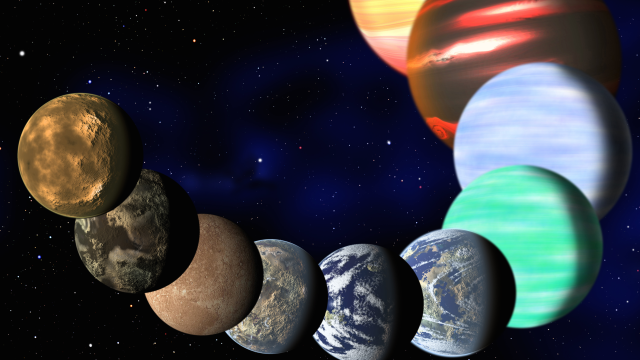In May 2013, NASA’s exoplanet-seeking spacecraft, Kepler, seemed doomed. Two of four wheels that stabilised its telescope had malfunctioned — and NASA appealed to scientists from around the world for ideas to salvage its mission. Yesterday, it announced the discovery of a brand-new super-Earth 180 light years from our own.
“To paraphrase Mark Twain, the report of the Kepler spacecraft’s death was greatly exaggerated,” reads the first line of a Harvard-Smithsonian Center For Astrophysics statement about the discovery, which described a new planet called HIP 116454b that circles its sun every 9.1 days and is more than twice the size of Earth:
HARPS-N showed that it weighs almost 12 times as much as Earth. This makes HIP 116454b a super-Earth, a class of planets that doesn’t exist in our solar system. The average density suggests that this planet is either a water world (composed of about three-fourths water and one-fourth rock) or a mini-Neptune with an extended, gaseous atmosphere.
But the events that led to the discovery of this new exoplanet is even more remarkable than the discovery itself, in some ways. No, Kepler’s bad wheel didn’t suddenly start working again. In fact, it seemed fairly certain that the craft’s life was over back in 2013. The New York Times even reported the dramatic memorial poem composed by one Berkeley astronomer: “Let jet aeroplanes circle at night overhead/ Sky-writing over Cygnus: Kepler is dead.”
But NASA, in a desperate attempt to keep the $US600 million Kepler useful, wasn’t ready to give up, and asked for proposals to send the craft on a second, alternative mission. One of those proposals — called K2 — was actually put into place.

The basic problem with the loss of the reaction wheels is that the telescope needs at least three wheels to keep a fixed eye on far-away stars, since Kepler works by looking at those stars and documenting “transits,” or flickers of light that occur when a planet passes in front of the starlight.
So what Kepler needed was another stabilizer to keep its eye fixed — which the scientists behind K2 proposed creating by harnessing the pressure of sunlight hitting the spacecraft as an ad hoc reaction wheel. “If properly positioned, the spacecraft can be balanced against the pressure much as a pencil can be balanced on your finger,” explains NASA. Incredibly, the plan worked — a brilliant bit of software engineering has managed to put Kepler back into commission, with a little help from the sun’s solar pressure.
So while our new friend HIP 116454b may not be the habitable planet so many have hoped for, this discovery is definitely worth celebrating. [NASA; New York Times]
Lead image: This artist rendering released Monday Jan. 7,2013 by Harvard-Smithsonian Center for Astrophysics shows the different types of planets in our Milky Way galaxy detected by NASA’s Kepler spacecraft. A new analysis of Kepler data found there are at least 17 billion planets the size of Earth. (AP Photo/Harvard-Smithsonian Center for Astrophysics)
